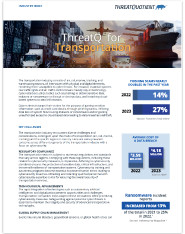THREATQ FOR:
The Transportation Industry
The transportation industry consists of air, rail, marine, trucking, and warehousing sectors, all interwoven with physical and digital elements, rendering them susceptible to cyber threats. For instance, essential systems like traffic lights and air traffic control towers heavily rely on technology. Cyber attackers utilize tactics such as phishing to obtain sensitive data, malware or ransomware to disrupt or destroy data, and breaching cloud-based systems to steal information.
Key Industry Challenges
REGULATORY COMPLIANCE
The transportation sector is subject to numerous regulations and standards that vary across regions. Complying with these regulations, including those related to cybersecurity measures, is imperative. Adhering to cybersecurity standards ensures the protection of sensitive data, critical infrastructure, and the overall resilience of transportation systems. Cybersecurity training and awareness programs become essential to prevent human errors leading to cybersecurity breaches. Attracting and retaining qualified personnel with cybersecurity expertise is vital for ensuring the overall security o transportation services.
TECHNOLOGICAL ADVANCEMENTS
The rapid integration of technologies such as automation, artificial intelligence, and digitalization presents opportunities and challenges. Transportation companies must adapt to these innovations while prioritizing cybersecurity measures. Safeguarding against potential cyber threats is essential to maintain the integrity and security of advanced transportation technologies.
GLOBAL SUPPLY CHAIN MANAGEMENT
ThreatQ Secures the Transportation Industry
CONSOLIDATE
all sources of external (e.g., E-ISAC, OSINT) and internal (e.g., SIEM) threat intelligence and vulnerability data in a central repository.
ELIMINATE
noise and easily navigate through vast amounts of threat data to focus on critical assets and vulnerabilities.
PRIORITIZE
what matters most for your environment.
PROACTIVELY HUNT
for malicious activity which may signal malicious activity, denial of service attacks and other disruptions and potential harm to customers, employees and constituents.
FOCUS
on known security vulnerabilities in currently active exploits which may impact regulatory status and security posture.
ACCELERATE ANALYSIS
and response to attacks through collaborative threat analysis that enables shared understanding and coordinated response.
AUTOMATE
threat detection, investigation and response.

An exclusive community for threat intelligence information sharing
The Power of ThreatQ
The ThreatQ Platform has taken a data-driven approach to security operations. This approach allows security teams to prioritize based on threat and risk, collaborate across teams, automate actions and workflows and integrate point products into a single security infrastructure.

